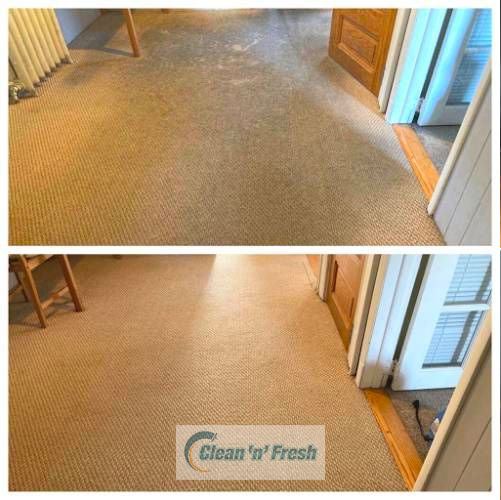Do you really need a professional upholstery cleaner or can you do it yourself?
If you have kids, then you know keeping food, muddy feet, crayons or paint off your couch is a challenge and especially disheartening because you hate seeing that beautiful and expensive couch or other furniture go to the dogs, so to speak. Professional upholstery cleaning can almost always get your couch looking new or nearly new again, but you can’t be calling in a pro every time Henry has his way with your furniture.
So what do you do? Develop some good DIY couch-cleaning skills, that’s what.
This guide will walk you through the ins and outs of cleaning your couch on your own, in many cases without the need for professional upholstery cleaning services until you really need it for that extra deep clean.
From understanding the importance of identifying your couch’s material to mastering homemade cleaning solutions, we’ve got you covered. We’ll also dive into the essentials needed for the job, share tips for specific types of couches, and provide effective stain-removal techniques. Plus, we’ll offer advice on maintaining a clean couch to prolong its life and keep it looking its best.
Why consider cleaning your couch yourself?
Immediate results
Having a few DIY skills up your sleeve can be a lifesaver when your little one spills Kool-Aid or paint on the couch, and your next upholstery cleaning is still months away.
Economical compared to professional services
Opting for DIY couch cleaning is, needless to say, highly economical, significantly saving costs when compared to the expenses of hiring professional cleaning services. And since kids and pets don’t just soil your furniture one day a year, no one can afford to be calling a pro every time a spot calls. So learning how to do this yourself is a good idea.
If you know how, you can respond immediately to spills and stains
A standout advantage of DIY couch cleaning is the capability to immediately tackle spills and stains. Acting swiftly can prevent permanent damage, preserving both the appearance and longevity of your couch. This level of immediacy is often not possible with professional services, which may require scheduling appointments in advance, thus allowing stains to set and become harder to remove.
Essentials for DIY couch cleaning
If you want to be a kick-ass DIY couch cleaner, you’re going to have to have the right tools and solutions on hand.
Vacuum with upholstery attachment for dust removal
A vacuum cleaner equipped with an upholstery attachment is indispensable for eliminating dust and loose debris, ensuring the couch is primed for an in-depth cleaning process.
Mild detergent or specific upholstery cleaner
Opt for a mild detergent or an upholstery-specific cleaner to cleanse effectively while safeguarding the fabric’s integrity and appearance.
Soft-bristle brush for gentle scrubbing
Employ a soft-bristle brush to delicately scrub the couch. This tool is key to dislodging dirt and stains without causing damage to the upholstery’s delicate fibers.
Microfiber cloths for application and drying
Microfiber cloths stand out for their application and drying prowess, as they leave no lint behind and facilitate a streak-free finish, preserving the couch’s aesthetic.
Spray bottle for solution application
A spray bottle proves essential for the uniform application of cleaning solutions, allowing for controlled coverage that ensures thorough cleaning without fabric saturation.
Identifying couch material
Identifying the material of your couch is a crucial first step in the DIY cleaning process, as it dictates the most effective and safe cleaning methods to employ. The manufacturer’s tag is often the best source of information, revealing the cleaning codes: W for water-based cleaners, S for solvent-based cleaners, WS for either, and X for vacuum-only cleaning. Understanding these codes is essential as it ensures that the chosen cleaning approach is perfectly aligned with the material’s specific needs, thereby preventing damage and extending the life of your couch.
This knowledge empowers homeowners to customize their cleaning strategy to the exact type of upholstery, guaranteeing optimal results while preserving the couch’s appearance and durability.
Homemade cleaning solutions
Homemade cleaning solutions offer a cost-effective and eco-friendly alternative to commercial cleaners, enabling customization of ingredients to match the specific needs of various couch materials. These DIY mixtures not only clean effectively but also minimize the risk of damaging delicate upholstery, ensuring the longevity and maintenance of the couch’s appearance.
Vinegar and water for fabric upholstery
A mixture of vinegar and water serves as an effective, eco-friendly cleaner for fabric upholstery, adept at lifting stains and neutralizing odors without the use of harsh chemicals.
Olive oil and vinegar for leather
Olive oil and vinegar combine to create a gentle yet effective cleaning solution for leather couches, not only removing dirt but also nourishing the material and maintaining its natural shine.
Baking soda and water for synthetic materials
A paste made from baking soda and water proves to be a powerful cleaning agent for synthetic materials, effectively tackling tough stains and odors, and leaving the surface fresh and revitalized.
Cleaning fabric couches
Cleaning fabric couches involves a series of steps designed to ensure a thorough clean without damaging the material.
Vacuum to remove surface dust and particles
Vacuuming is the first crucial step, essential for removing surface dust and particles, setting the stage for an effective deep clean.
Spot test cleaner on inconspicuous area
It’s important to perform a spot test with the cleaning solution on a hidden section of the couch to ensure it does not adversely affect the fabric.
Apply cleaner lightly, avoiding saturation
Light application of the cleaner, avoiding saturation, is key to preserving the couch’s material and preventing damage.
Use brush and cloths for dirt removal
Employing a soft-bristle brush and microfiber cloths facilitates the gentle yet thorough removal of dirt and stains from the fabric.
Air dry or use fans to speed up drying
To finalize the cleaning process, air drying or utilizing fans accelerates drying time, making the couch ready for use without lingering dampness.
Cleaning leather couches
Cleaning leather couches demands a gentle approach to safeguard their texture and aesthetic.
Vacuum gently to avoid scratching leather
Vacuum gently with a soft brush attachment to efficiently remove dust without causing scratches, protecting the leather’s integrity.
Wipe with a slightly dampened cloth
A slightly dampened cloth is ideal for gently lifting surface dirt, ensuring the leather is clean and ready for conditioning without being overly wet.
Apply leather conditioner to preserve texture
Applying a leather conditioner is key to nourishing the leather, maintaining its suppleness, and preventing cracks, thus preserving its luxurious texture and appearance.
Stain removal techniques
Effective stain removal techniques are crucial for preserving the appearance and longevity of couches.
Rubbing alcohol for ink stains
Rubbing alcohol effectively dissolves ink stains, making it a reliable choice for quick and efficient stain removal.
Baking soda for grease absorption
Baking soda is highly effective in absorbing grease, drawing out the stain from the fabric to leave it clean and grease-free.
White vinegar and water for wine stains
A solution of white vinegar and water acts as a natural and potent cleaner for lifting wine stains, ensuring the fabric remains undamaged.
Enzymatic cleaner for pet stains and odors
Enzymatic cleaners are specially formulated to tackle pet stains and odors, breaking down the biological matter for a deep and odor-free clean.
Technique for avoiding spot bleed
I think this has happened to everyone. You add water on a spot to remove it and the spot bleeds further. Let’s avoid that. I love this tip a car detailer left here in Reddit:
“What you’re experience is called wicking. The cleaner combines with the stain substance, and spreads out further than the original stain. There’s a couple things you can do to help fix this.
Rather than spraying it directly on the stain, spray around the stain first, outlining it with the cleaner essentially. Then, spray the actual stain. This will ensure any of the stain that is broken down and combined with the cleaner won’t spread out, rather, spread into the cleaner. This will cause it to be very diluted by the time it spreads far, preventing further staining.
Additionally, you will want to add additional water when extracting. First do a dry pass, getting as much as the cleaner out as possible without introducing additional water. Then you can behind doing passes with added water.
Be sure to dry liberally with a microfibre towel.”
Maintaining a clean couch
Maintaining a clean couch is vital for prolonging its lifespan and ensuring it remains a cozy and welcoming feature in your home.
Weekly vacuuming to prevent dirt buildup
Weekly vacuuming is essential to eliminate surface dust and prevent the deeper accumulation of grime, keeping the fabric fresh and extending its lifespan.
Clean spills immediately to prevent staining
Promptly cleaning spills is crucial to avoid them setting into the fabric, significantly reducing the likelihood of permanent stains.
Use throws and covers in high-use areas
Employing throws and covers in areas of frequent use not only protects the couch from wear and spills but also facilitates easier cleaning and maintenance.
Annual deep clean or as needed
Inviting a pro in for an annual deep clean, or more frequently as needed, is the best way to get your couch and all your furniture looking new again.
When should you hire a professional upholstery cleaner?
The results you get from cleaning your couch yourself may be fine, especially if you’re just treating new spots and spills, but what you can accomplish cannot come close to what a professional furniture cleaner can do for you. They’ve been trained in how to get out the toughest spots. They know which solutions are best for your furniture, they have superior strength professional equipment, and, in most cases, can get your furniture looking new again.
Just look at what we have accomplished for our clients.
Budget is a consideration for sure, but if you can afford it, we recommend professional upholstery cleaning once a year to keep your furniture looking new and to extend its life.
If you’re on Long Island in New York and would like a quote for cleaning your couch and other furniture, click one of the buttons below.
Let the Professionals at Clean 'n' Fresh Clean Your Upholstery
We’ve got truck-mounted hot water extraction equipment that is needed to clean deep and get your furniture looking new again! Read more about our professional upholstery cleaning on Long Island. Or request a quote!


- Beware cheap carpet cleaning companies. They’re not what they seem. - October 21, 2024
- How to remove chocolate from your couch - October 21, 2024
- DIY couch cleaning - October 21, 2024





